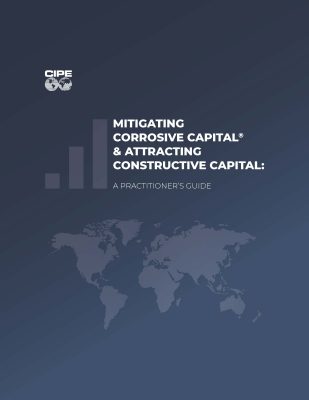 For years, CIPE has studied the effects of foreign investment on economies and governments around the world, documenting the many ways investments undermine or support market and democratic institutions in recipient countries, as well as identifying actions to strengthen economic resilience. This led CIPE to develop the twin concepts of Corrosive Capital® and Constructive Capital to differentiate between harmful and helpful investment. Corrosive Capital is a trademark of CIPE.
For years, CIPE has studied the effects of foreign investment on economies and governments around the world, documenting the many ways investments undermine or support market and democratic institutions in recipient countries, as well as identifying actions to strengthen economic resilience. This led CIPE to develop the twin concepts of Corrosive Capital® and Constructive Capital to differentiate between harmful and helpful investment. Corrosive Capital is a trademark of CIPE.
Constructive Capital refers to financial flows that are well governed at the funding source and destination and respond to market opportunity. It is characterized by transparent terms, conformity to market principles, and accountability to an array of stakeholders in the recipient country. The benefits of Constructive Capital include deeper markets, inclusive growth, and greater trust in public institutions.
By contrast, Corrosive Capital refers to financing, whether state or private, that lacks transparency, accountability, and market orientation. It exploits and widens governance gaps to the detriment of economic, political, and social development in recipient countries. Corrosive Capital tends to originate in non-democratic and non-market-oriented countries. While it may be relatively easy to access, it carries hidden costs.
CIPE launched the Corrosive and Constructive Capital Initiative in 2017 to help countries close governance gaps that Corrosive Capital exploits and prepare recipient countries to embrace Constructive Capital opportunities with lesser risk to democracy, institutions, and sovereignty. Since the initiative’s launch, CIPE and its partners around the world have carried out programs in more than 30 countries and published over 60 reports on Corrosive and Constructive Capital. This body of work has followed three strategic lines of effort.
The first line involves initiatives to close governance gaps exploited by Corrosive Capital. These projects are aimed at identifying and addressing speci fic regulatory and oversight de ficiencies on the side of the donor or recipient. The second line of effort involves setting the conditions to attract Constructive Capital. This approach seeks to attract quality investments with transparent and accountable rules, and to encourage practices of responsible investing. The third line of effort entails mainstreaming dialogue of Corrosive and Constructive Capital investments and raising public awareness of their implications for local economies and governance. This approach buttresses investment mechanisms and rules with the inclusion of voices from all sectors of society, including the private sector, to ensure an investment climate rooted in the public interest and individual freedom.
This report distills CIPE thought leadership on Corrosive and Constructive Capital, and highlights diverse partner approaches to these topics, to assist reformers and practitioners in choosing policies or programs. This guide is for government of ficials, economic development practitioners, civil society organizations, business associations, and investors seeking to understand on-the-ground challenges and opportunities of foreign investment. With the bene fit of the guide, the reader will be able to articulate reform objectives, select strategies or methodologies that fit their purpose and context, follow actionable steps for practitioners, and organize effectively for success.
Published Date: August 21, 2025
